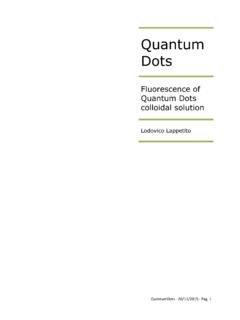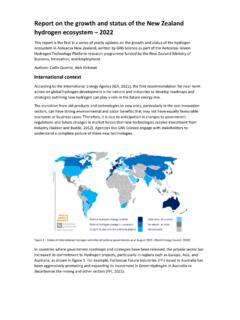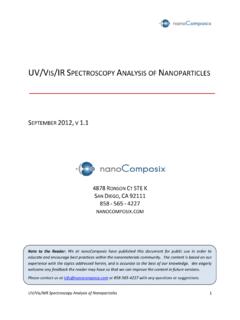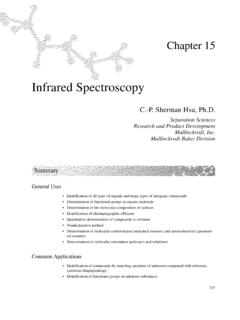Transcription of Diffraction Grating Spectrometer - PhysicsOpenLab
1 Theremino System Spettrometro_ENG Page 1 Diffraction Grating Spectrometer Design and Collected Spectra Theremino System Theremino System Spettrometro_ENG Page 2 Table of contents Design and Components .. 6 Theory of Diffraction Grating .. 6 Diffraction Grating Specifications .. 8 Portable Spectrometer Construction .. 9 Benchtop Spectrometer 10 Spectra of Lamps .. 11 Spectral 14 Hydrogen .. 14 Carbon Dioxide .. 15 Nitrogen .. 15 Spectra of Flames and Plasma .. 16 Emission and Atomic absorption spectra .. 17 LED Spectra .. 18 Laser Spectra .. 20 Sun Spectrum .. 22 Wien Law / Black body radiation .. 24 Comparison with Reference Spectra .. 25 CFL Lamp .. 25 Neon Lamp .. 26 Sodium-vapor 27 absorption Spectroscopy .. 28 absorption Spectrometer Design .. 28 Water .. 29 Red Wine .. 29 Blue Food Dye .. 30 Yellow Food Dye .. 30 Blue Ink .. 30 Fluorescence Spectroscopy .. 31 Fluorescence Spectrometer Design .. 31 Fluorescence Excitation Sources.
2 32 Fluorescence Theory .. 33 Spectroscopy of Organic Pigments .. 35 Chlorophyll .. 35 Theremino System Spettrometro_ENG Page 3 Phycoerythrin .. 37 Anthocyanins as pH Indicator .. 38 Carotenoids .. 40 Betalaine .. 41 Spectroscopy of Fluorescent 43 Stilbenes Triazine (Optical Brightener) .. 43 Fluorescein Sodium (Uranine) .. 44 Eosin .. 45 Acridine Orange .. 46 Rhodamine B .. 47 Rhodamine 6G .. 48 Green Fluorescent Dye .. 49 Methylene Blue .. 50 Crystal Violet .. 51 Methylene Blue Malachite Green Crystal Violet Acriflavine (Preparation for Fungal infections) .. 52 Phthalocyanine .. 53 Erythrosine .. 54 Coumarin .. 55 Spectroscopy of Edible Oils .. 56 Extra Vergine Olive Oil .. 56 Peanut Oil .. 57 Sunflower Oil .. 58 Corn Oil .. 58 Soybean Oil .. 58 Almond Oil .. 59 Sesame Oil .. 59 Castor Oil .. 59 Spectroscopy of Vitamins .. 60 Cyanocobalamin (Vitamin B12) .. 60 Riboflavin (Vitamin B2) and Pyridoxine (Vitamin B6) .. 61 Retinol (Vitamin A).
3 61 Spectroscopy of Food Substances .. 62 White Wine .. 62 Wine Vinegar .. 62 Isoflavones (Soy Sauce) .. 63 Theremino System Spettrometro_ENG Page 4 Green Walnut Extract (Liqueur Nocino) .. 63 ProtoPorphyrin (Egg Shell) .. 64 65 Rose Siroop .. 66 Rhubarb Extract .. 66 Ale Beer .. 67 Dark Beer .. 67 Stout Beer .. 67 Pistachio Extract .. 68 Green Tea .. 68 Spectroscopy of Drugs .. 69 Hematoporphyrin .. 69 Sodium Salicylate .. 70 Piroxicam .. 71 Spectroscopy of Various Compounds .. 72 Pyranine .. 72 Perfume .. 72 Bleaching Detergent .. 72 Methyl Salicylate .. 73 Quinine .. 73 Urine .. 74 Hemoglobin .. 75 Gasoline .. 76 Anthracene .. 76 Tetracene (Naphthacene) .. 77 Motor Oil .. 77 Bergamot Essential Oil .. 78 Chamomile Essential Oil .. 79 Orange Essential Oil .. 80 Orange Blossoms Water .. 80 Curcumin Essential Oil .. 81 Spectroscopy of Inorganic Compounds .. 82 Strontium Aluminate .. 82 Uranium glass .. 83 Halogen Inner Bulb .. 83 Theremino System Spettrometro_ENG Page 5 LYSO Scintillator Crystal.
4 83 Raman Spectroscopy .. 84 Chemiluminescence Spectroscopy .. 85 Blue LightStick .. 86 Green LightStick .. 86 Yellow LightStick .. 86 Purple LightStick .. 87 Orange LightStick .. 87 Red LightStick .. 87 Spectroscopy of Quantum Dots .. 88 Optical Properties .. 88 Adopted Quantum Dots .. 89 CdTe Hydrophilic Quantum Dot Green .. 90 CdTe Hydrophilic Quantum Dot Yellow .. 90 CdTe Hydrophilic Quantum Dot Orange .. 91 CdTe Hydrophilic Quantum Dot Red .. 91 CdTe Hydrophilic Quantum Dot Dark Red .. 92 Theremino System Spettrometro_ENG Page 6 Design and Components Webcam : NEW TRUST MEGAPIXEL WEBCAM PRO 1024x1280 Diffraction gratings : holographic 1000 linee/mm 600 linee/mm Collimating lens slit 100micron / slits built with razor blades / micrometric adjustable slit Portable Spectrometer Theory of Diffraction Grating A monochromatic light beam that is incident on a Grating gives rise to a transmitted beam and various diffracted beams , at angles that depend on the ratio between the distance between the lines of the Grating and the wavelength of the light.
5 So, if the light beam is composed of multiple wavelengths, the decomposition of the beam into its components is obtained. The light with a longer wavelength is deflected to a larger angle with respect to the incident direction (angle of Diffraction ) . For each wavelength more rows can be observed. The number of rows that are counted from the middle line, which is not skewed with respect to the incident beam and is taken as a reference , it is said "order" and is often denoted by the letter m. The Diffraction gratings can act both for transmission and for reflection of the incident light depending on the light scattering takes place on the same side or the opposite side of the light source . The transmission gratings are composed of a transparent plate on which are created many small strips that do not allow the passage of the radiation. In this way you get many small slits whose figure generated on a screen is solved by a method analogous to that used for the interference.
6 The reflection gratings are constituted by a reflective layer (mirror) on which are created many small strips or grooves that do not allow the reflection of the radiation. They are used in monochromators and spectrometers . The distance between the slits, known as " Grating pitch" , in the gratings used in spectroscopy is of the same order of magnitude as the wavelength of the light to be analyzed . In practice, the patterns are usually characterized by the number of engravings per unit length , often expressed in lines per millimeter (l/mm). Theremino System Spettrometro_ENG Page 7 The fundamental property of the gratings is that the angle of deviation of all the refracted beams depends on the wavelength of the incident light. Thus, a Grating separates a beam of polychromatic light in its wavelengths components, so the Grating is a dispersive tool. When a light beam is incident on a Grating is diffracted in different beams.
7 The beam corresponding to the direct transmission is called zero-order Diffraction . The convention in use denote the not deflected beam with m = 0 . Respect to the direction identified by the reference beam is possible to measure the Diffraction angle that characterizes each deflected beam . m can assume positive or negative values depending on that the deflected beam is to the right or left of the zero order beam (this depends on the convention used for the sign of the angles). Denoting by d the Grating pitch and the wavelength of the incident radiation can be written : When the beam hits at angle i the Grating . The sign in the formula depends on the choice of the Convention on the sign of the angles. From the previous relation it can be seen that a beam of polychromatic light is divided into its components from violet ( which is the color characterized by shorter wavelength ) till to red; instead in a glass prism the angle of deviation is greater for violet, so the sequence of colors is reversed.
8 Comparison between the spectra obtained from a Diffraction Grating (1), and from a refraction prism (2). Longer wavelengths (red) are deflected more, while the shorter ones (violet) are deflected less. The light from a lamp seen through a transmission Grating which shows three Diffraction orders. The order m = 0 corresponds to the direct transmission through the Grating . In the first positive order (m = +1), colors with longer wavelength (from violet to red) are deflected at higher angles. The diffracted beams of different colors and corresponding to consecutive orders can overlap, this phenomenon becomes more likely to grow in the order of Diffraction . Moreover, in an experiment the observed Diffraction lines are never infinitely narrow ( as expected from the theory ) , this phenomenon is a consequence of the not ideal experimental conditions and because of the Doppler effect.
9 The equation of the Grating shows that the Diffraction angle depends only on the pitch of the Grating and not by the shape of the slits. The efficiency of the Grating can also depend on the polarization of the incident light . Theremino System Spettrometro_ENG Page 8 Diffraction Grating Specifications Type of Grating Lines/mm Space between lines (nm) Diffraction for different wavelengths 400nm 500nm 600nm 700nm 800nm 900nm Paton Grating 600 1600 14 18 22 26 30 34 Holographic Grating 1000 1000 24 30 37 44 53 64 Gratings in use Holographic Grating with 1000 lines/mm and holographic Paton Grating with 600 lines/mm Portable Spectrometer Design : Benchtop Spectrometer Design : 40o Slit Webcam Grating Slit Webcam Grating Collimator lens Webcam Lens Theremino System Spettrometro_ENG Page 9 Portable Spectrometer Construction Details of webcam and Diffraction Grating slit, slit and 1mm slit Scattering screen Webcam Grating Theremino System Spettrometro_ENG Page 10 Benchtop Spectrometer Construction Inside view with collimating lens, Grating and webcam Detail of the micrometric slit and the Spectrometer assembled Calibration CFL lamp Webcam Grating Lens Slit Theremino System Spettrometro_ENG Page 11 Spectra of Lamps CFL lamp just lit presence of lines broadened by phosphorus infrared emission ( > 750nm) CFL lamp after warm-up (detail 400nm 800nm)
10 No infrared emission Infrared Lines 579nm 576nm 546nm 436nm Theremino System Spettrometro_ENG Page 12 Incandescent lamp 25W continuous spectrum with maximum at ~ 800nm Halogen lamp 70W continuous spectrum more emission at shorter (temperature is increased) Low pressure neon lamp discrete spectrum with many narrow lines Wood lamp UV emission at 370nm with tiny visible tail beyond 380nm Theremino System Spettrometro_ENG Page 13 Sodium-vapor lamp (street lamp) evidence of the sodium double absorption line at a 589nm further lines at 568nm, 616nm, 514nm, 498nm all corresponding to emission lines of the sodium spectrum Xenon lamp Due to the broad extension of the emission, from 350nm to 950nm, this lamp is used in absorption and fluorescence spectroscopy Theremino System Spettrometro_ENG Page 14 Spectral Lamps Hydrogen Low pressure hydrogen spectral lamp with high voltage high frequency power supply.






